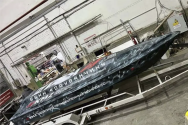some more numbers and performance characteristics from that interview . 48 Kinzal missiles Ukraine counted.
Tambov Kyiv shortest distance is about 500 miles and Vinnytsia is 620miles.
It takes two minutes to 3.5 reach. . It seem avg speed is much more than Mach 11.
Its about 300 drones a month production. but interception rate is low compared to what they mention daily.
Tambov Kyiv shortest distance is about 500 miles and Vinnytsia is 620miles.
It takes two minutes to 3.5 reach. . It seem avg speed is much more than Mach 11.
Its about 300 drones a month production. but interception rate is low compared to what they mention daily.
Since February 24, 2022, Russia has launched 3,700 Shahed-type kamikaze drones and 7,400 missiles over Ukraine. The AFU Air Force spokesman Yuriy Ignat revealed this data.
On the telethon air, Ignat said that Ukrainian air defence destroyed 2,900 kamikaze drones, which the Russian Federation began to launch in September 2022.
Air defence also destroyed approximately 1,600 missiles out of 7,400 launched by Russia.
A third of these missiles are S-300 and S-400. About 900 are Iskander-M ballistic missiles.
Out of 48 Kinjal missiles launched over Ukraine, Ukrainian troops managed to destroy only 15.
He added that Russia launches "Kinzhal" missiles from the Tambov region so that a missile can fly to Kyiv in two minutes to Vinnytsia in about 3.5 minutes.Why so few? Because we didn't have Patriot before. And at the moment, Patriot allows you to work on "Kinzhals", Ignat explained.
In December, the Defence Intelligence of Ukraine (DIU) stated that the Russian occupiers had accumulated more than 800 high-precision missiles and were probably preparing for massive strikes with the onset of cold weather.
The DIU representative, Andriy Yusov, said on the telethon air that Russia's defensive and industrial complex produces more missiles than before the full-scale invasion of Ukraine. However, the Russian Federation cannot accumulate missiles due to constant airstrikes.

